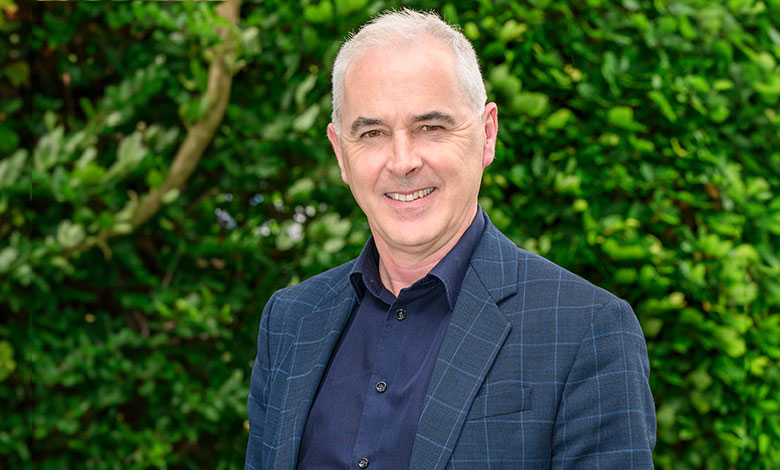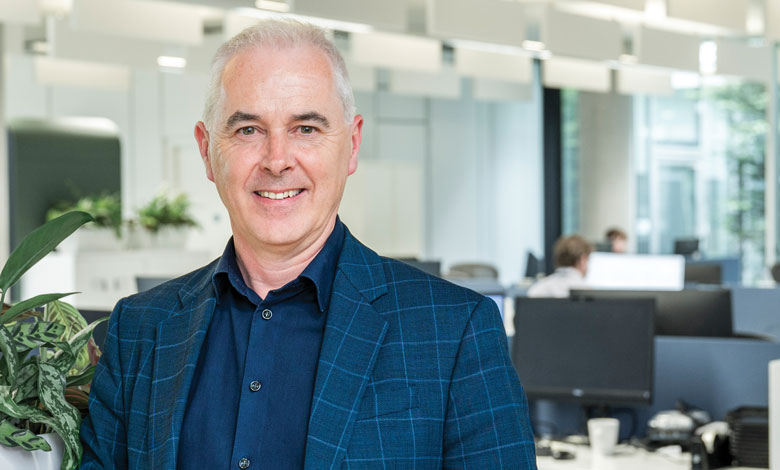Enabling the energy transition

In the week that government published its first ever National Biomethane Strategy, Gas Networks Ireland Chief Executive Officer (CEO) Cathal Marley speaks with eolas Magazine about his organisation’s centrality to the energy transition, ensuring resilience in the energy system, and embracing the potential of renewable gases.
In 2018, government determined that the two principal subsidiaries of the Ervia Group – Gas Networks Ireland and Uisce Éireann – would be separated into standalone, publicly owned, and commercial utilities. Upon the appointment of a new Gas Networks Ireland executive team in 2022, CEO Cathal Marley observed that it was the “ideal time to stand back and review our strategy”.
Discussing the strategy, Marley outlines its three core elements: continued performance; enabling the energy transition; and transforming the gas network.
Firstly, the new strategy outlines that Gas Networks Ireland will continue to contribute to Ireland’s energy system, supplying 30 per cent of the State’s overall energy demand, 40 per cent of all heating needs, and an average of up to 50 per cent of total electricity generation.
“As such, Gas Networks Ireland remains at the heart of Ireland’s energy landscape,” the CEO remarks.
“The National Biomethane Strategy is a fantastic starting point.”
Cathal Marley, Chief Executive Officer, Gas Networks Ireland
Secondly, the strategy recognises Gas Networks Ireland’s role in the energy transition. “Gas-fired power stations are absolutely necessary,” he asserts, adding: “While Gas Networks Ireland does not generate electricity, it connects power stations to the gas grid. As we speak, we are in the process of connecting 10 new gas-fired power stations by the end of the decade.
“In the previous 10 years, we connected a single station. That demonstrates the rapid expansion that is now under way. Gas Networks Ireland is committed to playing its part in ensuring that those new stations are in place. Without them, and in advance of offshore wind energy at scale, the energy transition is not going to happen.”
Thirdly, the strategy is cognisant of the centrality of the gas network to the energy transition and the need to transform it, over the next 20 or 25 years, to carry renewable gases rather than natural gas. “As such, the volumes of biomethane that Gas Networks Ireland will carry will increase exponentially in the next five to 10 years,” he forecasts.
Gas network
Ireland’s only indigenous natural gas supply, the Corrib gas field, currently supplies about 20 per cent of demand, while the remaining 80 per cent of natural gas is imported primarily via the interconnector pipeline at Moffat, Scotland.
Over the next eight years, the supply from Corrib is anticipated to deplete to between 3 per cent and 5 per cent of demand. Biomethane has the potential, therefore, to replace Corrib with an indigenous and renewable source of gas.
Indeed, Gas Networks Ireland anticipates that the target of 5.7TWh of biomethane by 2030 – which is about 10 per cent of Ireland’s gas demand – will be almost tripled to around 14TWh, equating to between 25 per cent and 30 per cent of required gas as natural gas demand reduces.
“Consequently, we are preparing our gas network for that change,” Marley advises, noting: “Ireland’s 14,725km gas network is relatively young, with pipes installed from the mid-1970s onwards. The network is in incredibly good condition relative to our UK or European counterparts.”
Emphasising that it is important to distinguish biomethane from hydrogen, the CEO explains that the former is structurally identical to natural gas, whereas “the hydrogen molecule is much smaller”.
“Biomethane is indistinguishable from natural gas, and we do not have to make any adjustments to our natural gas network. We can transport biomethane up to any volume on our natural gas network,” he says.
Biomethane potential
Biomethane is a carbon neutral renewable gas produced from farm and food waste through a process known as anaerobic digestion (AD).
“Recognising the potential of biomethane early on, we were the first people in Ireland to hold discussions about its significance, engaging with partners across Europe, particularly in Denmark,” the CEO outlines.
In September 2023, this culminated in the publication of Gas Networks Ireland’s Biomethane Energy Report which identified 176 expressions of interest for potential biomethane projects equating to around 15TWh of biomethane.
“While we understand that not all of these projects will be delivered, it was an incredible demonstration of the level of interest. Industry was signalling that it is ready to go but also that it needed certainty from government.
“That inspired government to develop the National Biomethane Strategy which in turn demonstrates its commitment to the role that biomethane will play in decarbonising the gas network. Providing an indigenous source of renewable energy, and enhancing Ireland’s energy security, biomethane will also diversify farm incomes,” he says.
Biomethane strategy
In late May 2024, Minister for the Environment, Climate and Communications, Eamon Ryan TD and the Minister for Agriculture, Food and the Marine, Charlie McConalogue TD announced the publication of Ireland’s National Biomethane Strategy. Focusing on a framework of five interlinking pillars and 25 aligned actions, the strategy is the initial step in delivering as much as 5.7TWh of indigenously produced biomethane by 2030.
Welcoming the publication of the National Biomethane Strategy, and its vision that “Ireland will have developed a sustainable biomethane industry of scale” by 2030, the Gas Networks Ireland CEO’s enthusiasm is evident.
“It is really welcome,” Marley remarks, adding: “We have been working on this for around six years. In fact, we commissioned our initial reports on biomethane back in 2018. These were very comprehensive and not dissimilar to the Government’s strategy.”
Financial supports
Emphasising that a dominant focus for the biomethane industry has been on government’s implementation of the right financial supports to stimulate development. Marley outlines the three possible levers open to government.
“The first is capital support to help AD producers to build plant. Given the number of AD plants required to achieve the 2030 targets, this is a relatively small amount of money, around €40 million, but government has indicated that this is only the beginning.
“The second lever is an obligation on end-users to receive renewable gas. This will increase over time up to 10 per cent of their usage.
“The final lever, which has not been used, is a feed-in tariff which would guarantee AD producers a price for their renewable gas. Often such a tariff is necessary to enable banks to finance investment in the renewable energy industry and as such it may be implemented in the future. That is what has been deployed to pronounced effect in Denmark, for instance, accelerating the development of the biomethane industry there,” he clarifies.
Overall, from Gas Networks Ireland’s perspective, “the National Biomethane Strategy is a fantastic starting point” with government “exhibiting clear commitment” against an ambitious delivery target.
Gas Networks Ireland’s role
Equipped with an unrivalled expertise and knowledge of transporting gas, Gas Networks Ireland’s role in achieving the Government’s vision for biomethane is delivering connections to ensure that renewable gas can be transported to wherever it needs to go.
Having already connected Ireland’s first renewable gas central grid injection (CGI) in Cush, County Kildare, Gas Networks Ireland is now developing a larger CGI facility in Mitchelstown, County Cork, which will be entering construction by the end of 2024 and commissioned in early 2025.
“In 2019, Gas Networks Ireland successfully injected indigenous biomethane into the gas network at the first purpose-built facility in Cush. While it is a relatively small volume, equating to less than 1 per cent of Ireland’s total gas supply, we have treated it as a pilot project, demonstrating our expertise.
“We have learnt a huge amount from that in terms of control and quality. By the end of 2024, we will also have 10 larger plants directly connected into the network, equating to 12 per cent of the 5.7TWh target set by government,” Marley illustrates.
EU exemplars
Elsewhere across the EU, there are around 1,300 biomethane plants in operation. Biomethane industries are burgeoning across France, the Netherlands, and in Denmark, where close to 40 per cent of gas consumed is biomethane.
“In the last year, Gas Networks Ireland has organised three trips to visit to biomethane stakeholders, including a major biomethane plant in Denmark. The first included our own staff, the second brought together policymakers, and the third delegation will comprise industry customers. The rationale is to develop a comprehensive understanding of how biomethane works elsewhere,” Marley explains.
Green hydrogen potential
Alongside biomethane, the transition to renewable gases will be accompanied by green hydrogen. Identifying the potential for green hydrogen in Ireland as being “very significant”, the Gas Networks Ireland CEO makes two observations.
“Firstly, unlocking Ireland’s hydrogen potential hinges on the speed at which offshore wind energy capacity is developed. We will require a significant amount of offshore wind energy to produce adequate volumes of hydrogen; multiples of what is required to meet our electricity demand. I think that will happen, but it will take time,” he says.
“Secondly, once hydrogen is being produced in an adequate volume, it must then be stored. Surplus renewable energy from offshore wind will be converted to hydrogen, stored, and then used in power stations – to generate electricity at times when there is now wind – and/or directed to high-heat industry which cannot be electrified because it requires high-density energy. Another potential use is in HGVs that cannot be electrified.”
However, while fully cognisant of the potential of green hydrogen, the CEO has doubts on “the speed at which it can be delivered”. In a scenario where Ireland does not produce enough indigenous green hydrogen in the immediate future, he emphasises interconnection with the Britain where “they may be moving faster on hydrogen production”.
“In Britain, National Gas is set to begin blending volumes of hydrogen – up to 2 per cent – into its network in the next five years. As such, I anticipate that the first hydrogen in Ireland will be delivered via the interconnectors rather than offshore wind. Gas Networks Ireland must ensure that our interconnectors and our network can carry up to 2 per cent hydrogen,” Marley insists.
Blending
Acknowledging that a Gas Networks Ireland technical and safety feasibility study that determined transporting blends of hydrogen and natural gas via the gas network was both safe and feasible, the National Hydrogen Strategy recognises that “blending may offer an initial demand sink in the short term”. Notably, however, it concludes: “Overall, blending is not seen as a high priority end-use for renewable hydrogen.”
The end-use for green hydrogen, Marley acknowledges, is not blending for industries or in residential heating which can be electrified. Instead, blending will be a transitional end-use.
“We have been fully aligned with that, so there are no surprises there. However, the National Hydrogen Strategy also recognises that hydrogen must be blended initially, during a transitional period. This transitional period is undefined. However, until significant volumes of green hydrogen are produced, hydrogen is likely to be blended with natural gas in the gas network.
“The Hydrogen Strategy also recognises that the gas network is the optimal infrastructure for transporting green hydrogen around the country. Similarly, if in the long term, we produce surplus volumes of hydrogen, the gas network can enable green hydrogen export to European markets via a repurposed interconnector.”
Collaboration
In anticipation of hydrogen being imported into the Irish network, Gas Networks Ireland is investing enormous resource into ensuring the feasibility of safely transporting these hydrogen/natural gas blends.
Working in collaboration with third-level institutions, such as University College Dublin and Ulster University, Gas Networks Ireland is seeking to ensure that there are several programmes in place to enable the network to safely carry hydrogen up to blends of 20 per cent.
On top of this, Gas Networks Ireland is working alongside other energy companies to develop the Celtic Hydrogen Cluster in east Cork to demonstrate end-use and stimulate the development of a hydrogen valley.
“The Celtic Hydrogen Cluster is designed to leverage the existing concentration of energy producers and consumers in close proximity to an existing natural gas network. In essence, it is small-scale model of Ireland.
“We are working with other to demonstrate the viability of hydrogen across a complete value chain. It is a really important project, and it is the beginning of what must happen at scale; collaboration across energy companies.”
Resilience
As Ireland unlocks the potential of zero carbon gases, such as biomethane and green hydrogen, the role of the natural gas network will shift.
Today, Gas Networks Ireland supplies significant amounts of gas equating to 50 per cent of power generation. However, in time, increasing renewable generation capacity will come on stream.
“Given the intermittency of weather dependant renewable energy, Gas Networks Ireland role will increasingly shift to transporting gas when the sun does not shine and the wind does now blow, thereby enabling the energy transition and ensuring the continued resilience for the Irish energy system.
“Over the next 20 years, and beyond, there will be a transition to increasing renewable electricity with gas as a backup. Following that, renewable electricity will be used to generate green hydrogen which will in turn begin to displace the need for natural gas. Meanwhile, biomethane will emerge as a significant contributor to the energy mix over the next five years,” Marley articulates.
Ultimately, this will unlock an enhanced energy mix, with increasing renewable electricity, the introduction of biomethane, a gradual reduction in natural gas, and the gradual introduction of hydrogen.
Eventually, it is expected that biomethane and hydrogen will assume the backup role currently played by natural gas amid greatly increased electrification. There is speculation as to how quickly this will happen and the final composition of that energy mix.
“If I was to predict what will happen over the next 15 years, there will be increasing renewable electricity, a relatively small amount of green hydrogen, an acceleration of biomethane, and still a fair proportion of natural gas,” Marley summarises.
“At some point in the future,” the CEO projects, “possibly by 2050, there will be a tipping point whereby zero carbon gases accelerate to the point whereby hydrogen and biomethane accelerate to the point where the reducing amount of natural gas required to support the energy system will be completely renewable.
“Gas Networks Ireland’s future role is assured in that we will be transporting biomethane and hydrogen instead of natural gas. Once natural gas is totally displaced, it is possible that we will split our networks into a hydrogen network and a separate, dedicated network for biomethane. Our vision, therefore, is defined by a continued need for the gas network, though it will undertake a different role, with different gases,” he concludes.







